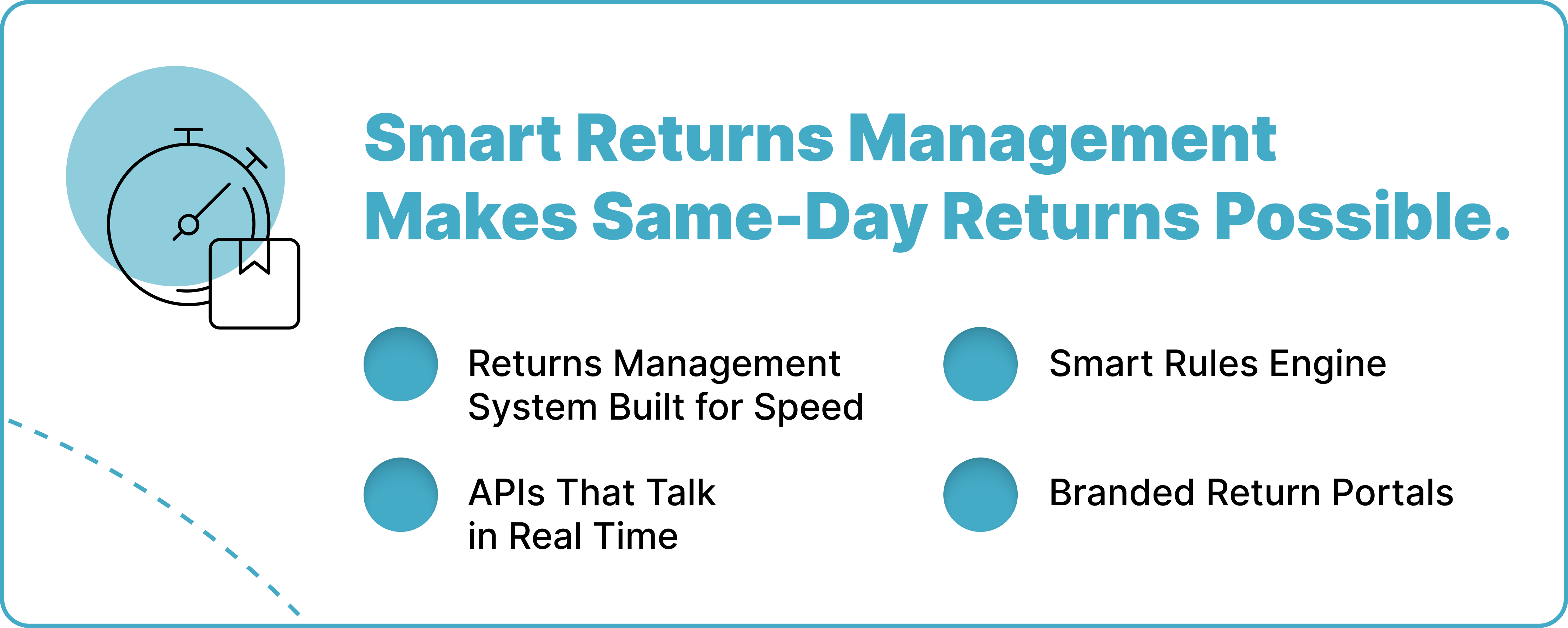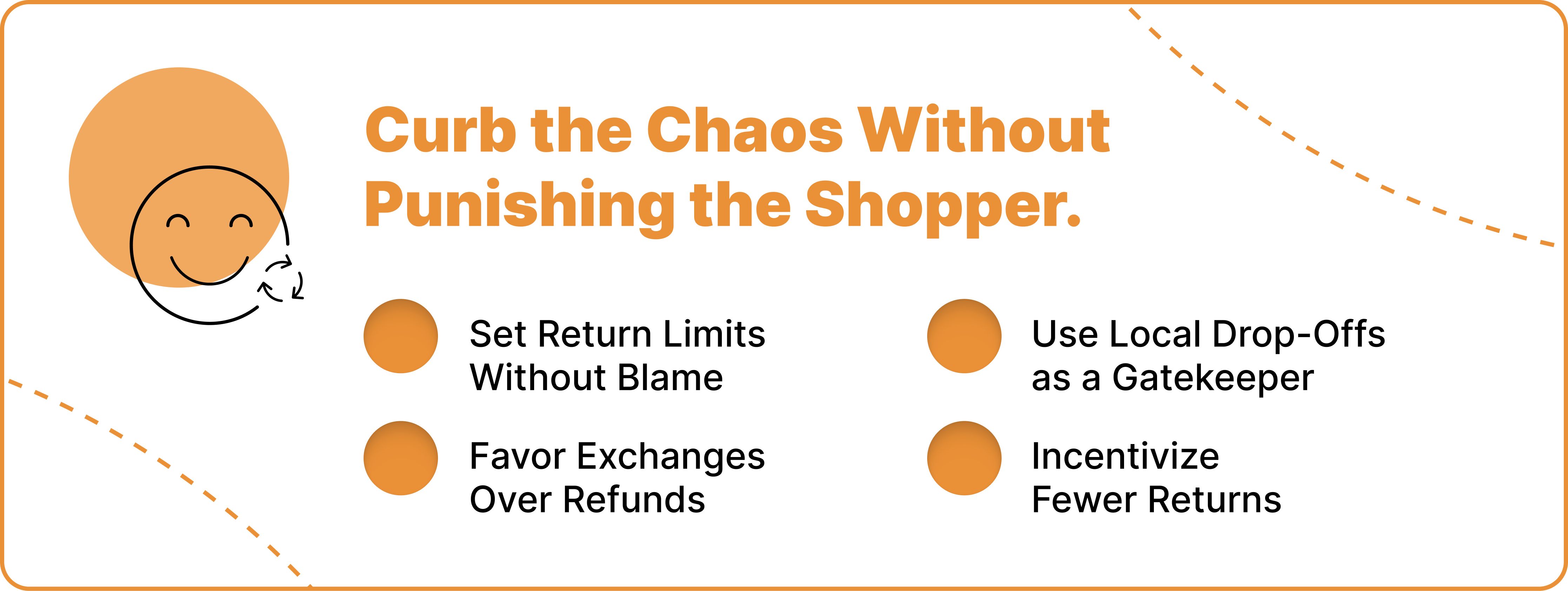Handling Retail Therapy Disruptions Through Same-Day Returns Operations

Same-day delivery fundamentally changed the tempo of warehouse operations. And now, same-day returns is resulting in another wave of evolution, pushing logistics teams to take back control as returns processes directly impact customer experiences.
Fast returns in online shopping, often triggered by emotional impulse buying or what we call retail therapy, are now stretching systems built for a slower, simpler returns management process. Consumer psychology plays a significant role here, as the emotional drivers behind retail therapy and the demand for same-day returns are deeply rooted in how shoppers seek to regulate their emotions and restore well-being.
With a single click, customers can buy comfort, and with another click, they can reverse it. But it is the reverse logistics teams that are left to clean up the mess in real time, directly affecting customer satisfaction. The dopamine hit of a “buy now” moment is matched by the instant regret of a “return today” mindset. Feelings such as anxiety, mood changes, and excitement can strongly influence both purchasing and returning behaviors, as shoppers seek relief or a boost in their emotional state. Making shopping decisions and the act to shop can help individuals regain a sense of control or alleviate negative emotions, using the process as a coping mechanism.
If you treat same-day returns like an annoying exception, you risk losing customer trust. At the same time, if you welcome or treat them like an operational standard, you could risk overwhelming the system and significant losses in the short term. These rapid changes in items purchased and purchasing behaviors present new challenges for the business side of logistics, requiring companies to adapt quickly to shifting consumer demands.
Retail Therapy Fuels Fast Buying and Faster Regret
Retail therapy is emotional and often temporary. A shopper can tap “Buy Now” during a lunch break, and by dinner, the regret sets in. Fast fashion, social media trends, and influencer-driven shopping increase snap purchases. However, shoppers want the freedom to change their minds as quickly as they make them.
This attitude has led to the rise of the try-and-return culture. Customer orders are placed and processed quickly, enabling rapid deliveries and returns. People now buy five items to keep one. Or buy two sizes to return one. What used to take a week now happens within hours. And that pressure flows straight to the warehouse. Fashion, beauty, home, electronics, and gadgets retailers, along with many e-commerce businesses and small and local businesses, see this shift every day. Post-purchase reversal has become part of the purchase itself.
Same-Day Returns Break Traditional Operations
Logistics teams have spent decades improving outbound speed. But the returns cycle time hasn’t kept up, resulting in decreased efficiency. The resulting effect is that for most retailers, when returns come back the same day, every process in the reverse supply chain is shortened because:
- Refunds must be processed instantly.
- Restocking must be error-free and fast.
- Pickup must be scheduled within hours.
About 30% of online customers think fast refunds contribute to a pleasant returns experience. But the challenge is that most warehouse return flows were designed for days, not hours, which contrasts with the fast pace of daily life. In traditional logistics, longer delivery times and greater delivery distances were the norm, but today’s hyperlocal models demand much faster and more localized solutions. So it is not uncommon for returns management teams to face bottlenecks such as:
- Manual intake: too slow for real-time.
- Labor mismatch: fewer people trained for returns.
- Disconnected systems: no visibility across supply chain tools.
As same-day returns continue impacting the traditional reverse logistics process, retailers that refuse to adjust risk delayed refunds, incorrect inventory counts, and missed resale windows. All of these factors lead to higher costs and lower return satisfaction scores. However, optimizing these processes can result in cost savings and even significant cost savings for businesses. Adapting to these new operational standards provides the benefit of faster, more efficient returns management.
Hyperlocal Logistics Is the Only Way Forward
Returns can’t all go back to the central warehouses. Not anymore. That model can’t match the speed of retail therapy-driven returns. Hyperlocal logistics leverages local warehouses to improve product availability, enable convenient delivery, and drive improved customer satisfaction. It also increases access to products and meets rising demand for fast returns. This is where hyperlocal logistics changes the game, especially when coordinated with delivery partners.
There are different models in hyperlocal logistics: the inventory-led model focuses on managing local inventory warehouses for quick fulfillment, the aggregator model connects multiple suppliers through a platform to facilitate efficient returns, and the hybrid model combines both approaches for greater flexibility. Collaboration with suppliers and the use of aggregator models help optimize returns and meet customer expectations.
What It Means
Hyperlocal logistics refers to handling returns near the customer — inside stores, drop-off networks, lockers, or micro-fulfillment hubs. It is a logistics strategy increasingly leveraged to shrink the travel window between return and refund, benefiting local businesses.
What It Solves
- Lower shipping costs: Less long-haul transport.
- Faster refunds: Customers get money back quicker.
- Better inventory health: Return-ready inventory gets sorted faster.
What It Needs
- Smart hubs with return intake
- Integration with POS, OMS, and WMS
- Clear routing rules to match location with item category
When a shopper returns a pair of shoes to a local locker and gets their refund before they get home, that’s real-time return management at work. But this system only works when reverse logistics teams have full control, real-time tracking, and system visibility for every person or stakeholder involved.
Smart Returns Management Makes Same-Day Returns Possible

Reverse logistics teams must stop relying on manual checkpoints. Same-day operations only work when supported by connected, smart software. Artificial intelligence can further enhance returns management by enabling smarter automation and real-time decision-making. And you don’t even need advanced technologies to make this work.
Here’s what the average tech stack must include to make it work, improving customer experiences and creating new sales opportunities through efficient returns:
1. Returns Management System (RMS) Built for Speed
Tools like ReverseLogix give logistics teams a single command center. Our platform connects return requests, tracking, refunds, and re-stocking — all in one view.
2. APIs That Talk in Real Time
Same-day performance needs more than batch processing. Refund approvals, item scans, and inventory updates must happen as returns move.
3. Smart Rules Engine
Not every return should follow the same flow. In the current market, the returns management system must be able to:
- Flag abuse or broken patterns
- Approve repeat customers faster
- Route items to local or central hubs based on cost and condition
4. Branded Return Portals
Speed starts with the shopper. A self-service portal with guided steps improves accuracy, reduces return errors, and makes warehouse handling easier.
With the right system, you can cut down warehouse return bottlenecks, improve data, and support customer-first returns that feel modern, not messy, ultimately leading to increased efficiency .
Curb the Chaos Without Punishing the Shopper

Fast returns feel expensive. But they don’t have to crush margins and can actually drive sales if managed effectively . The fact is that it all comes down to control, not crackdown.
Here’s how returns managers can balance generosity with discipline, allowing companies to better manage returns.
1. Set Return Limits Without Blame
Use customer behavior analytics to spot shoppers who abuse returns. Using this information, you can better manage their returns by giving warnings or introducing tiered perks (not punishments).
For example: “We noticed frequent returns on similar items. Please note that our team can assist you live if you need sizing help.”
2. Favor Exchanges Over Refunds
Push customers toward swaps instead of full refunds. Offer free shipping or same-day credit for exchanges. This way, you can preserve revenue and speed up the re-stocking process, capturing the benefits of efficient operation .
3. Use Local Drop-Offs as a Gatekeeper
Make local return drop-off the fastest option because it helps with localized fulfillment and cuts processing time.
4. Incentivize Fewer Returns
Offer small loyalty perks for customers who keep most of what they buy. This creates a sense of reward, not punishment, appealing to the psychological aspects of customer behavior.
Ultimately, you want the returns to feel simple but not careless. Smart boundaries protect the operation and the experience.
Same-Day Returns Are a New Standard, Not an Exception
Customer behavior has changed. Fast buying now expects fast undoing, and logistics leaders must accept this. The return is no longer a problem to solve later. It is part of the same experience that starts at checkout.
With the rise of online retailers and changing consumer expectations, businesses now need to offer same-day return services to stay competitive and meet customer demands.
Retailers who treat it with care and urgency win more trust. Here’s your return playbook for managing same-day returns triggered by retail therapy, particularly relevant for e commerce businesses:
- Shift the return hubs closer to the buyer.
- Monitor behavior to balance freedom and control.
- Build real-time workflows into your software stack.
- Empower your logistics team with tools built for speed.
- Offer emotional clarity in returns policies and communication.
- Use data and analytics to determine the best return strategies for your business.
Returns should not slow your brand down. They should show how fast, smart, and caring your operation really is, reflecting operational efficiency.
How ReverseLogix Creates a Stress-Free Returns Experience
Tech can’t replace empathy. But it can support it. And that is where ReverseLogix shines. The platform was built with tools that remove chaos from the reverse supply chain management. This way, retailers can:
- Offer branded, easy-to-use portals.
- Customize returns policies without extra work.
- Use built-in analytics to reduce repeat returners.
- Send auto-updates to ease post-purchase emotions.
Want to know how ReverseLogix can help? Get a demo today.
Frequently Asked Questions (FAQs)
Fast, emotional shopping — also known as retail therapy — often leads to regret soon after purchase. Customers want the option to reverse their shopping decisions quickly. This has created a new norm where returns are initiated the same day an order arrives, impacting future repeat purchases.
They compress every step of the returns cycle time. Warehouses must process returns faster, systems must sync in real time, and refunds must be triggered without delay. This adds pressure on teams used to slower, more linear reverse logistics processes.
Teams reduce handling time and shipping costs and transportation costs by shifting return processing to local hubs or drop-off points through hyperlocal logistics. Coupled with connected systems, this ensures efficient delivery and that returns don’t pile up at central warehouses.
A smart returns management system with automation, API integrations, and built-in return rules makes it possible. Platforms like ReverseLogix support real-time return management, automate item routing, and give visibility across all return channels.
